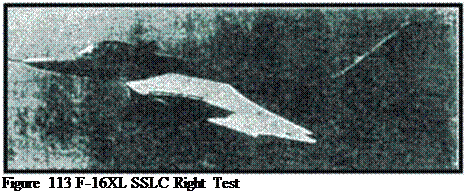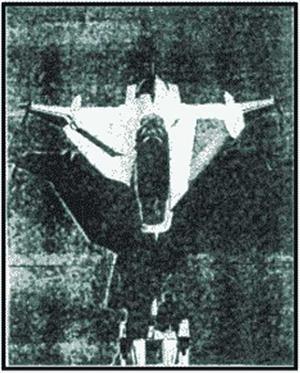Supersonic Laminar Flow Flight Tests
At NASA-Langley an F-I6XL was modified for supersonic laminar flow investigations (F – 16XL SSLFC. Figure 113). A glove with suction was designed (3931 and applied to the aircraft. It was flown with successful laminarisation by suction behind a round subsonic leading edge at supersonic speeds (394). But apparently laminar flow was realized only in dive (at no lift) conditions. and there are difficulties in understanding the results and in validating the methods used
 |
The reason seems to be insufficient resolution of the boundary layer profiles in the solution of the undisturbed flow, including ihc second derivatives (ca. 20 points in the boundary layer normal to the surface instead of about 80 required). Nevertheless, a suction system able to provide laminar flow at supersonic flight was demonstrated.
 |
Since then a second flight test scries with the F-I6XL SSLFC was planned using two different new glove designs for the right and left hand wing (Figure 114) [395] and completed 1396).
![]() F-16XL SSLFC with Two Gloves
F-16XL SSLFC with Two Gloves
In any case, flight experiments arc essential for validation of laminarisation technology. They cannot completely be replaced by ground tests. Due to high cost they should be limited to a minimum. This may become possible by improvements in theory and ground test facilities, but some validation flight tests will remain essential.
18.5 Conclusion
Laminarisation is a promising technology for future Supersonic Commercial Transports. First investigations indicate significant improvements of aircraft efficiency.
Theoretical prediction of the transition laminarAurbulent requires substantially improved CFD-solulions of the undisturbed 3D-flow.
Stability analysis itself must be improved to describe coupling of different instabilities (CFI and TS1), but also to respect for non-adiabatic walls and HMI.
A quiet Ludwicg tube for Mach 16 to 2.4 and high Reynolds number (RcL ca. 300 Mio) should be used in Europe to allow for high quality ground based check experiments
A new design approach must be developed, based mainly on
• theoretical predictions
• and partial simulation by turbulent tests in classical supersonic wind tunnels
• but it must rely on selected checks in a quiet high Reynolds ground test facility
• and validation by carefully designed flight tests.











